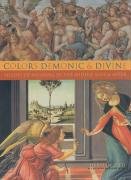Items related to Colors Demonic and Divine: Shades of Meaning in the...

Synopsis
Color has been a subject of heated debate for as long as anyone can remember. Is it an innate part of material objects or a trick of perception and light? Is it merely superficial and decorative, or does it reveal deeper meaning? Is it the manifestation of divine presence on Earth or evidence of Satan's cunning? This debate captured the medieval imagination and influenced every aspect of life in the Middle Ages -- an era that was truly obsessed with color.
Unlike the drab images popularized in films and television programs, parades of vibrant color were on display at every level of medieval European society. Not only did clothing sport gaudy and often clashing colors, but food, statues, animals, and even hair and beards flaunted the most brazen coloration. Yet not everyone revered color; many believed it to be an ephemeral, worldly deception and a symptom of immorality. As the Middle Ages drew to a close, perceptions of color gradually became emblematic of broader cultural issues. Black and blue -- which were primarily associated with asceticism, sorrow, and humility -- became the colors of choice for royalty and the urban aristocracy, while bright, flashy colors came to be associated with the devil -- who, it was believed, had painted the world in tempting hues to lure humanity into sin and away from the path to eternal salvation. As a result, every God-fearing person began to avoid colorful displays, choosing instead more somber shades, a preference still seen today in the blacks and dark blues of evening wear and business attire.
Colors Demonic and Divine ranges over painting, fashion, poetry, heraldry, religion, and history to tell the story of medieval attitudes toward color and the profound and pervasive influence they still have on modern society.
"synopsis" may belong to another edition of this title.
About the Author
Herman Pleij lectures on Dutch historical literature at the University of Amsterdam. He is the author of the Dutch best-seller Het Gilde van de Blauwe Schuit (The guild of the blue barge), an account of the rituals surrounding the celebration of Carnival in the Middle Ages, and the critically acclaimed book De sneeuwpoppen van 1511 (The snowmen of 1511), a study of the rise of urban culture and middle-class morality in the Netherlands during the Middle Ages. His last book, Dreaming of Cockaigne: Medieval Fantasies of the Perfect Life, was published by Columbia in 2001.Diane Webb, a professional musician and translator, lives in the Netherlands and Italy. She specializes in the translation of historical and art-historical literature.
From Publishers Weekly
Unfortunately for brunettes, gentlemen have preferred blondes since the 12th century, according to this engaging chromatic history lesson chronicling the rise of carnivalesque colors during the Middle Ages. The blues, crimsons and purples that adorned everything from churches to women’s dress were shaded with meaning about a person’s class, political persuasion or character. Blond hair, for example, embodied the warm, light-bearing rays of the sun, while black hair was considered dirty and evil. Brown hair, skin or clothing was also deemed sinister, yet ironically, brown eyes were seen as piously humble. Blue eyes, on the other hand, signaled insanity or sexual promiscuity. The rare brown-eyed blonde symbolized feminine perfection. Pleij’s book, ably translated by Webb, is filled with plenty more delightfully archaic beliefs and considerations of how they’ve changed with the times. Overall, people in the Middle Ages regarded color as part of God’s creative miracle, he says; for them, color was "not a substance but a quality made manifest by light," as seen in the rich, vivid stained glass and paintings of the period. But the Reformation put an end to the gay parade of colors. Over time, black, white and gray crept back into European wardrobes, art and decoration. The opulent colors of the Middle Ages, once used to create class distinctions, were left to the lower classes, and were thus soon considered garish. In the world of modern designer hues, which the author describes as the "progress of discoloration," black still spells sophistication, while muted pastels—those "colors that dare not speak their name"—flourish among the masses. 20 color photos.
Copyright © Reed Business Information, a division of Reed Elsevier Inc. All rights reserved.
"About this title" may belong to another edition of this title.
- PublisherColumbia University Press
- Publication date2005
- ISBN 10 0231130236
- ISBN 13 9780231130233
- BindingPaperback
- LanguageEnglish
- Number of pages128
- Rating
Shipping:
US$ 25.85
From United Kingdom to U.S.A.
Search results for Colors Demonic and Divine: Shades of Meaning in the...
Colors Demonic and Divine | Shades of Meaning in the Middle Ages and After
Seller: *bibliosophy*, Exeter, United Kingdom
Soft cover. Condition: Fine. 2004, 124 pages, illus. colour | gently read copy - clean and bright, uncreased spine, free of name, notes etc | carefully packaged and dispatched from UK within two working days. Seller Inventory # col2406
Quantity: 1 available

